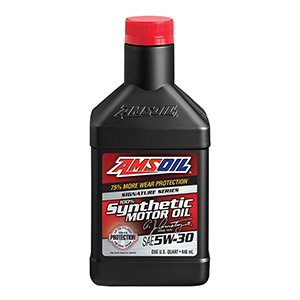Let’s Start With The Base Oil
If you start right… you can finish right.
If you start right… you can finish right.
AMSOIL is positioned as a leader in performance and protection, but what is its base oil?
All lubricating oils are made from crude oil refined to produce by-products of base oil. Each refining process eliminates undesirable components, resulting in various pure chemical components.
Based on independent testing, see how AMSOIL® synthetic lubricants compare against other top-shelf brands.

AMSOIL has always been known as the “First In Synthetic Lubricants®.” In 1972, AMSOIL used esters exclusively to create synthetic lubricants because they were the only widely available base oils. When Polyalphaolefins (PAOs) became readily available in the 1980s, this became the base oil for blending its products. Then, in 1999, in a court ruling Mobil® vs. Castrol®, the National Advertising Division of the Better Business Bureau led that…
Today, we define a synthetic lubricant in the following context and term:
Society of Tribologists and Lubrication Engineers (STLE) [2] explains synthetics as manufactured compounds that are not naturally occurring, and combining low-molecular-weight materials via chemical reactions into higher-molecular-weight structures makes these products.
Webster’s Dictionary in the chemical context defines synthetic to mean- of, relating to, or produced by chemical or biochemical synthesis, specially created artificially with synthesis (defined as “the production of a substance by the union of chemical elements, groups, or simpler compounds or by the degradation of a complex compound.”)
AMSOIL, a prominent name in the world of lubricants, has long been hailed as a leader in performance and protection. However, a recent debate has stirred among enthusiasts and consumers regarding the base oils used in their products. Some have questioned the use of Group III base oils and whether they qualify as genuinely synthetic. Perhaps this article can demystify the choice and significance of base oils in blending synthetic lubricants.
Before diving into the specifics of AMSOIL’s base oils, it’s essential to comprehend the various base oil groups and their properties. Machinery Lubrication provides an excellent resource for understanding base oils, which you can explore further[1]. The base oil groups are categorized based on their refining processes, with each additional process eliminating more of the undesirable components, resulting in pure chemical elements suitable for lubricating oils.
AMSOIL’s history in blending and marketing synthetic lubricants began in 1972 when they exclusively used esters to create their products. At the time, esters were the most widely available synthetic base oil. In the 1980s, they transitioned to using Polyalphaolefins (PAOs) as a base oil due to their superior properties. It wasn’t until 1999, following a court ruling in the Mobil vs. Castrol case, that the National Advertising Division of the Better Business Bureau classified Group III base oils as synthetic.
The debate surrounding what qualifies as a synthetic base oil revolves around different interpretations. The Society of Tribologists and Lubrication Engineers (STLE) defines synthetics as manufactured compounds, not naturally occurring, formed by combining low-molecular-weight materials via chemical reactions into higher-molecular-weight structures. In this context, synthetic base oils are intentionally created through chemical processes instead of naturally derived oils.
AMSOIL has addressed the concerns about its use of Group III base oils by emphasizing that it never stated that Group III oils were not synthetic. They highlight their history of utilizing various base oils, including esters and PAOs, for their unique properties. They claim that focusing on the type of base oil is a distraction from what truly matters, which is product performance and quality. They experiment with different synthetic base oils and additives to create a custom formulation that maximizes performance, and they refuse to disclose the specific base oils used to maintain their competitive edge.
The debate over what qualifies as a synthetic base oil has stirred the lubricant industry and raised questions about AMSOIL’s choice of base oils. While some may find the classification of Group III base oils as synthetic a recent development, AMSOIL maintains that they’ve always focused on product performance and innovation. They refuse to disclose the specific base oils they use, emphasizing their commitment to creating superior lubricants through a combination of various base oils and additives.
When choosing the best synthetic lubricants, what matters most is the end product’s performance and quality. AMSOIL upholds its reputation as a pioneer in synthetic lubricant technology, unwavering in its dedication to delivering top-tier products that set industry standards—they don’t just make it, they define it.
Various sources define “100% synthetic” and “full synthetic” differently. Some specify “100% synthetic” as motor oil solely derived from Group IV polyalphaolefin (PAO) base oils, while they characterize “full synthetic” as oil made from Group III base oils. Read more. What is the difference?
It’s important to note that there are significant performance variations among different base oil group categories. Generally, Group IV base oils exhibit the highest performance, followed by Group III, and Group II is the least favourable. However, it’s crucial to be aware of exceptions to this generalization. Additionally, it needs to be more accurate to assess motor oil performance solely based on the type of base oil used. Read more. Group III vs IV vs V base oils
Unlike food and drug companies that are required to disclose product ingredients, lubricant manufacturers are not held to the same standard. This lack of mandate can be confusing when shopping for synthetic motor oil, as store shelves are filled with oils labelled as “full synthetic,” “semi-synthetic,” “synthetic,” and even “100% synthetic.” What exactly are you getting when you open the cap on these bottles? Read more. How Much Synthetic Is In My Oil?